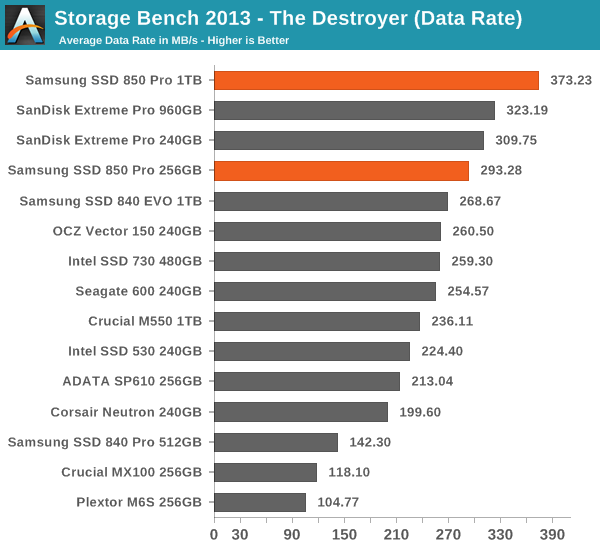Samsung SSD 850 Pro (128GB, 256GB & 1TB) Review: Enter the 3D Era
by Kristian Vättö on July 1, 2014 10:00 AM ESTAnandTech Storage Bench 2013
Our Storage Bench 2013 focuses on worst-case multitasking and IO consistency. Similar to our earlier Storage Benches, the test is still application trace based - we record all IO requests made to a test system and play them back on the drive we are testing and run statistical analysis on the drive's responses. There are 49.8 million IO operations in total with 1583.0GB of reads and 875.6GB of writes. I'm not including the full description of the test for better readability, so make sure to read our Storage Bench 2013 introduction for the full details.
| AnandTech Storage Bench 2013 - The Destroyer | ||
| Workload | Description | Applications Used |
| Photo Sync/Editing | Import images, edit, export | Adobe Photoshop CS6, Adobe Lightroom 4, Dropbox |
| Gaming | Download/install games, play games | Steam, Deus Ex, Skyrim, Starcraft 2, BioShock Infinite |
| Virtualization | Run/manage VM, use general apps inside VM | VirtualBox |
| General Productivity | Browse the web, manage local email, copy files, encrypt/decrypt files, backup system, download content, virus/malware scan | Chrome, IE10, Outlook, Windows 8, AxCrypt, uTorrent, AdAware |
| Video Playback | Copy and watch movies | Windows 8 |
| Application Development | Compile projects, check out code, download code samples | Visual Studio 2012 |
We are reporting two primary metrics with the Destroyer: average data rate in MB/s and average service time in microseconds. The former gives you an idea of the throughput of the drive during the time that it was running the test workload. This can be a very good indication of overall performance. What average data rate doesn't do a good job of is taking into account response time of very bursty (read: high queue depth) IO. By reporting average service time we heavily weigh latency for queued IOs. You'll note that this is a metric we have been reporting in our enterprise benchmarks for a while now. With the client tests maturing, the time was right for a little convergence.

Thanks to the excellent IO consistency, the 850 Pro dominates our 2013 Storage Bench. At the 1TB capacity point, the 850 Pro is over 15% faster than any drive when looking at the average data rate. That is huge because the 850 Pro has less over-provisioning than most of today's high-end drives and the 2013 Storage Bench tends to reward drives that have more over-provisioning because it essentially pushes drives to steady-state. The 256GB model does not do as well as the 1TB one but it is still one of the fastest drives in its class. I wonder if the lesser amount of over-provisioning is the reason or perhaps the Extreme Pro is just so well optimized for mixed workloads.











160 Comments
View All Comments
Pastuch - Wednesday, July 2, 2014 - link
When will we see Vnand in smart phones? This 16gb Nexus 5 is brutal! Always out of space.ajlueke - Wednesday, July 2, 2014 - link
Page 1, "Scaling below 20nm was seemed", I believe you intended "Scaling below 20nm was seen".Automaticman - Wednesday, July 2, 2014 - link
Can current EVO 840 users upgrade to Magician 4.4 and get the benefits of RAPID 2.0 (assuming they have >16GB DRAM)?bsd228 - Wednesday, July 2, 2014 - link
just as RAPID support was extended to the 840 PRO, I would expect this to support the 840 pro/evo soon, if not right off the bat.Automaticman - Sunday, July 6, 2014 - link
Well, I was certainly able to upgrade to Magician 4.4, and it did take a couple reboots while it was re-activating RAPID. I am going to guess and say yes it seems to be the new version of RAPID, but I don't see anywhere that it actually says RAPID 2.0 or any indication of how much memory it has available.sirvival - Wednesday, July 2, 2014 - link
Ah ok.When I select the 470 in Bench there is no slumber so I got confused.
Since power cosumption is a big thing in Mobile could you do the following:
Bench the impact on the Battery of a Laptop due to a fast drive.
E.g. drive A is fast but has the downside that it draws more under load as drive B which is slower. But since its done faster it returns to idle faster.
I mean impact on real world scenarios.
Or how much power was used for bench x etc. and have a average per hour or something like that.
sirvival - Wednesday, July 2, 2014 - link
damn this was to be a reply tohttp://www.anandtech.com/comments/8216/samsung-ssd...
sorry
Nickat - Thursday, July 3, 2014 - link
Thank you so much. You explained everything so well.Stokkolm - Thursday, July 3, 2014 - link
Newegg still has them for preorder at the more expensive price, hopefully they drop those before the release date.skarthikeyan - Monday, July 7, 2014 - link
Hi, How come random read is 106.8MB/sec and random write is 292.4MB/sec for the SSD 850 Pro 256 GB? Aren't writes supposed to be slower than reads?